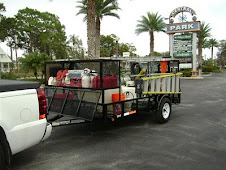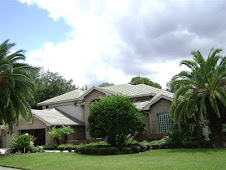Here is a very interesting Roof Cleaning article I ran into today. Very good read for someone interested in having their Shingle Roof Cleaned.
Chronicles of a retired home inspector ROOF CLEANING
POSTED: September 28, 2009
Save Print Email Read comments Post a comment
Email: "Chronicles of a retired home inspector ROOF CLEANING"
http://www.post-journal.com/page/content.detail/id/541138.html?nav=80
By DICK SENA, RETIRED HOME INSPECTOR, ASHVILLE, NY
Regardless of what the calendar says, Fall is here. Leaves changing and falling, cool evenings, dew on the vehicles every morning, and all of those projects that need to be done before the white stuff arrives. Lately I have had several people ask me the same questions, what is the black “stuff” on my roofing shingles? Can I get rid of it before winter? And how can I prevent it? Well, I have first hand experience with it because I dealt with it on my own house last year after watching it get worse over the two previous years. Just look around, you will see this in various degrees everywhere you drive. Mine showed up on relatively new roof of 8 years old at the time. I first contacted our regional GAF roofing representative several years ago after noticing it on so many roofs I inspected. As I climbed roof after roof I looked around neighborhoods and saw the dark blotches and streaks on the majority of homes. Of course he was very aware of the issue as he said he fields the same question many times per week. He explained it was an air born fungus that has migrated from the south. As he explained, I recalled all the blackened roofs on trips I’ve taken to Florida in the past. He said as it has made its way North, similar to a virus or an invasive species. Companies have experimented with additives to shingle granular to combat the problem. Shingle manufacturers like G.A.F. started adding zinc to the composition of their shingles. Many of you may have heard or seen the zinc strips on roofs that leach zinc compound onto the roof leaving a protective film called metal salts that mildew, mold, moss, etc. won’t grow on. I noticed this action years ago. Early in my construction days all shingles under pipe penetrations with galvanized flashings were perfectly clean. Galvanized metal has zinc in it. Copper flashings had similar effects. Someone had an "ah ha" moment and came up with full-length strips of zinc. I’ve used them with fairly good results and have some on my home. However, they did not control the airborne fungus although it worked great for moss growth.
It’s a complicated problem. Black roof algae as it’s commonly known as, is very common effecting 80% of the U.S. I’ve researched the problem and the hot humid states are the worst. A Florida home can be completely covered within four years while we see it sparingly on mainly north facing roofs. Black fungal growth can damage shingles and shorten life spans. Three methods of cleaning are suggested. 1. Trisodium Phosphate (TSP) and a touch of liquid soap. 2. Oxygen bleach 3. TSP 1 cup Bleach 1 gallon Water 4 gallons mixture There are many roof cleaners on the market but most are very expensive and require washing, brushing, etc. The most important thing is to be as gentle as possible. DO NOT POWERWASH! If you hire someone to clean your roof and they want to use a power washer even at a low pressure, tell them to take a hike, nicely of course. Any brushing, scrubbing, or pressure washing will remove the mineral gradules and limit the manufacturers warrantied lifespan of the shingles. I used Clorox. I know some people will disagree with me but it worked great. I treated the streaks with full strength in a pump sprayer, then I did the entire roof (only north side effected) with a 50/50 mix to even it out, hosed it off and with no effort it came off and has stayed off for 2 years. It did not kill any grass, flowers or plants. And hardly any grandules were lost. Of course no matter what you do, wet everything down first, don’t try it in full sun, cover and protect what you can and be careful! Stay off of steep roofs without fall protection, and make sure if you hire someone, they know what they are doing and that they have good insurance.
A few other points. Moss is also a problem. You will have to scrape it off first before washing. Lichens, often confused with black algae, are growths that look lace like. They eat into the shingle and can cause holes, I’ve also seen them on my roof and they really stick on the shingles. I treated them and left them on because when I scraped them off, it took the grandules with it. Finally if cleaning doesn’t work then you may have a defective shingle. The problem is called extractive bleeding and a supplier or reputable roofing contractor can help you out if needed.
Sticking with the roofing theme, if you need a roof, get ready for a shock, sticker shock that is. Shingles have skyrocketed and just went up another 5% on September 1st. Labor has always been high due to the extremely high cost of insurance, roofers have the highest cost per $100 for workman’s comp insurance. It’s been said that there is a shortage of asphalt due to the stimulus package road construction in the country. I'd like to know where because we surely don’t see any. I think most of you would agree we deserve a little of that money and they can start with I-86 from Salamanca to the PA border!
I’ve written in the past a lot about roofing and the high percentage of homes that needed roofs during my inspection years. Be careful when it comes to having an inspector look at a roof on the house you might buy or at that matter, a roofer pricing out a new roof. I’ve heard so many stories about additional costs of removal because of hidden roof layers. I’ve said it before and it’s worth repeating, don’t use an inspector that doesn’t go on the roof. You just can’t see everything from the ground. Just last week someone told me that their inspector refused to go onto the roof. This leads me into the story about hidden layers. Although I’ve seen it many times, roofers covering up the ends and edges with drip edge to make it appear like one layer, this was excessive. I was called in to do a structural inspection of an attic where the roof sagged in multiple areas. I noticed right away an extra wide drip edge, a custom made one I thought because I’ve never seen one so large. (A drip edge is the metal edging going around the roof to form a more durable edge and to create a drip lip to help funnel water into a gutter or away from siding and trim) Once inside the attic I found several split rafters and heavily stressed ridge boards and valley rafters, this was an old home with strong durable old growth lumber so experience told me that it wasn’t just the framing or heavy snow loads creating this problem. I went up on the roof that didn’t look too old and bent up the metal edge and found 5 layers of shingles! This incredible amount of weight the roof was never designed for was splitting and cracking rafters. Add snow load and you are asking for a disaster. I found out later, the previous inspector checked off 1 layer of roofing on his report. The most I found was 7 layers of a porch/foyer roof. The top layer was nailed with 3 inch roofing nails! Be smart; don’t be afraid to question people. It’s sad how many hidden problems I’ve found over the years and it burns me when it’s all about cheating someone or being too lazy to climb a roof, crawl into an attic or crawl space. Please always use the utmost caution when going onto a roof.
Thanks to all my readers and all the positive comments I’ve received and as always don’t hesitate to suggest a topic or ask a question. Until next time.
Dick received his Construction Technology Degree from Alfred State Building. He has taught adult education classes in building technology for several years for Jamestown Community College. He has over 30 years construction experience and twenty-three years with “Dick Sena’s Custom Building and Remodeling, Inc.” His experiences also include twenty-three years of home inspection experience with “Home Inspection Services of Jamestown, Inc.” After several years with the town of North Harmony planning board he is now an official town councilman.He is on the planning board town of North Harmony and has spent a number of years coaching girl’s softball. He and his wife, Carol, live with their four daughters in Ashville, NY.
Subscribe to Post-Journal
Cerified Master Roof Cleaner And Member Of "The Roof Cleaning Institute of America".
About Me
+(Small).jpg)
- All Surface Roof Cleaning and Pressure Washing of Pinellas County Florida
- Saint Petersburg, Florida, United States
- We specialize in Non pressure Roof Cleaning/Washing for Tile/Shingle Roofs,Driveways,Walkways,Pavers etc. We also Clean Exteriors of Homes/Buisinesses/Commercial Bldgs using a Soft Wash Cleaning Method. 727-543-3276 http://www.aspc.us Saint Petersburg Florida, Palm Harbor, Feather Sound, Safety Harbor, Clearwater, Countryside, Oldsmar,East lake Woodlads, Tarpon Springs, Largo,Seminole FL, Dunedin, Belleair, Belleair Beach, Indian Rocks, Indian Rocks Beach, Madeira Beach and Treasure Island. We also Provide Tile/ Shingle Roof Cleaning and Pressure Washing in Hillsborough County and Manatee County as well. Looking for the Highest Quality and Dependability? Call Us Today! Licenced and Insured for your protection and as Always, Estimates are FREE- 727-543-3276
Followers
Subscribe to:
Post Comments (Atom)


.jpg)
.jpg)
.jpg)
.jpg)

Some mold may be visible, such as white or black specks in the bathroom or along basement walls. A lot of basements are very humid and damp, and it's not uncommon to find some wall mold growing. If you have visible mold, then there is a pretty good chance that you have mold you cannot see as well.
ReplyDeletemold removal